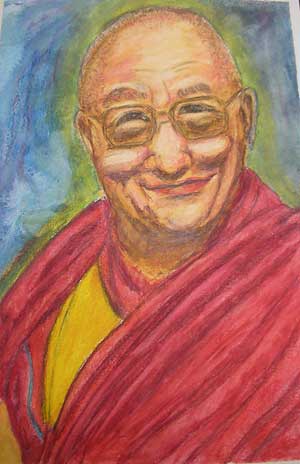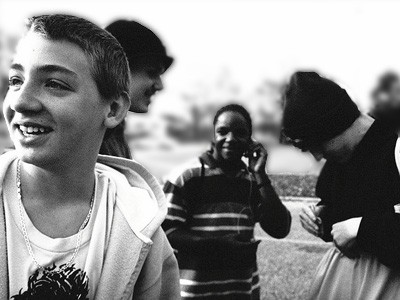The Sutra of the Three Heaps
The Bodhisattva’s Confession of Ethical Downfalls
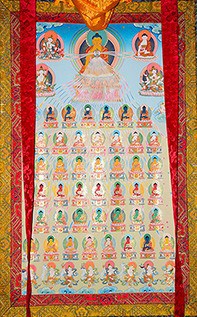
There are a variety of purification practices, The Bodhisattva’s Confession of Ethical Downfalls being one of the most popular. This text is also called The Sutra of the Three Heaps because the prose text after the names of the thirty-five Buddhas deals with three important topics: confession of downfalls, rejoicing at our own and others’ virtues, and dedication of merit. We all have done actions that we now feel badly about doing, and we have aspects of ourselves that we do not like and wish to change. Purification practices are excellent means to remove emotional burdens such as guilt, as well as to pacify the obstacles to our happiness and self-improvement created by the imprints of our destructive actions. Guilt over past actions is useless, only leaving us feeling helpless and hopeless. On the other hand, acting to purify the destructive imprints and afflictions is very productive. It helps us to change our bad habits and subdues obstacles to long life and success in our spiritual practice.
A complete purification practice consists of four opponent powers:
- The power of regret for having done the destructive action.
- The power of reliance: taking refuge, which restores our relationship with holy objects, and generating the altruistic intention, which restores our relationship with other sentient beings.
- The power of the remedial action, e.g. prostration, offering, reciting the names of the Buddha, reading or contemplating the Dharma, etc.
- The power of the promise not to repeat the action.
These four opponent powers are found in The Bodhisattva’s Confession of Ethical Downfalls, the Vajrasattva meditation, and other practices.
The Bodhisattva’s Confession of Ethical Downfalls: Prostrations to the 35 Buddhas
There are several visualizations of the 35 Buddhas. The easiest is to visualize Shakyamuni Buddha, golden in color, with 34 light rays coming from his heart. These light rays form five rows and upon each ray is seated a Buddha. The Buddhas in each row resemble one of the five Dhyani Buddhas.
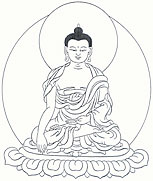
Akshobya Buddha
In the first row are the next six Buddhas mentioned in the prayer. They resemble Akshobya Buddha, blue, the left hand in his lap in the gesture of meditative equipoise, the right hand in the earth-touching gesture (on the right knee, palm down). However, the One Thus Gone, the King with Power over the Nagas, looks slightly different: he has a blue body, a white face, and his hands are folded together at his heart.
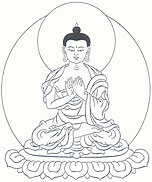
Vairocana Buddha
In the second row, the next seven buddhas resemble Vairocana Buddha, white, with both hands at the heart, the index fingers extended.
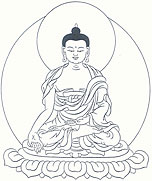
Ratnasambhava Buddha
In the third row, the next seven buddhas resemble Ratnasambhava Buddha, yellow. His left hand is in meditative equipoise, and his right hand is in the gesture of giving (on the right knee, palm outwards).
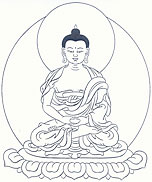
Amitabha Buddha
In the fourth row, the next seven buddhas resemble Amitabha Buddha, red, with both hands in meditative equipoise on his lap.
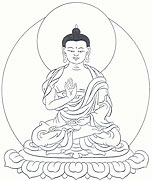
Amogasiddhi Buddha
In the fifth row, the next seven buddhas resemble Amogasiddhi Buddha, green. The left hand is in meditative equipoise and the right arm is bent at the elbow with the palm facing outwards.
Visualize that you are surrounded by all sentient beings in human form and that you are leading them in prostrating to the Buddhas. While prostrating, imagine much light coming from the Buddhas and flowing into you and into all the sentient beings around you. This light purifies all imprints of destructive actions and all afflictions.
After reciting the names of the 35 buddhas and the prayer of the three heaps—confession, rejoicing and dedication—you may also want to recite the “General Confession.”
After this, visualize the 34 Buddhas dissolve into Shakyamuni Buddha. He comes on top of your head and melts into golden light. The light descends through the crown of your head and goes to your heart chakra, in the center of your chest. Feel that all destructive karma and obscurations have been completely purified and that your mind has become inseparable from the Buddha’s pure mind of wisdom and compassion.
To increase the benefit of each prostration, first prostrate three times while reciting:
om namo manjushriye namo sushriye namo uttama shriye soha.
Continue to prostrate while reciting the names of the Buddhas and the confession prayer.
I, (say your name) throughout all times, take refuge in the Gurus; I take refuge in the Buddhas; I take refuge in the Dharma; I take refuge in the Sangha.
To the Founder, the Transcendent Destroyer, the One Thus Gone.1 the Foe Destroyer, the Fully Awakened One, the Glorious Conqueror from the Shakyas I bow down.
To the One Thus Gone, the Great Destroyer, Destroying with Vajra Essence, I bow down.
To the One Thus Gone, the Jewel Radiating Light, I bow down.
To the One Thus Gone, the King with Power over the Nagas, I bow down.
To the One Thus Gone, the Leader of the Warriors, I bow down.
To the One Thus Gone, the Glorious Blissful One, I bow down.
To the One Thus Gone, the Jewel Fire, I bow down.
To the One Thus Gone, the Jewel Moonlight I bow down.
To the One Thus Gone, Whose Pure Vision Brings Accomplishments I bow down.
To the One Thus Gone, the Jewel Moon, I bow down.
To the One Thus Gone, the Stainless One, I bow down.
To the One Thus Gone, the Glorious Giver, I bow down.
To the One Thus Gone, the Pure One, I bow down.
To the One Thus Gone, the Bestower of Purity, I bow down.
To the One Thus Gone, the Celestial Waters, I bow down.
To the One Thus Gone, the Deity of the Celestial Waters, I bow down.
To the One Thus Gone, the Glorious Good, I bow down.
To the One Thus Gone, the Glorious Sandalwood, I bow down.
To the One Thus Gone, the One of Unlimited Splendor, I bow down.
To the One Thus Gone, the Glorious Light, I bow down.
To the One Thus Gone, the Glorious One without Sorrow, I bow down.
To the One Thus Gone, the Son of the Desireless One, I bow down.
To the One Thus Gone, the Glorious Flower, I bow down.
To the One Thus Gone, Who Understands Reality Enjoying the Radiant Light of Purity, I bow down.
To the One Thus Gone, Who Understands Reality Enjoying the Radiant Light of the Lotus, I bow down.
To the One Thus Gone, the Glorious Gem, I bow down.
To the One Thus Gone, the Glorious One who is Mindful, I bow down.
To the One Thus Gone, the Glorious One whose Name is Extremely Renowned, I bow down.
To the One Thus Gone, the King Holding the Banner of Victory over the Senses, I bow down.
To the One Thus Gone, the Glorious One who Subdues Everything Completely, I bow down.
To the One Thus Gone, the Victorious One in All Battles, I bow down.
To the One Thus Gone, the Glorious One Gone to Perfect Self-control, I bow down.
To the One Thus Gone, the Glorious One who Enhances and Illuminates Completely, I bow down.
To the One Thus Gone, the Jewel Lotus who Subdues All, I bow down.
To the One Thus Gone, the Foe Destroyer, the Fully Awakened One, the King with Power over Mount Meru, always remaining in the Jewel and the Lotus, I bow down.
(Optional: If you wish to bow to the seven Medicine Buddhas)
To the Buddha, Renowned Glorious King of Excellent Signs, I bow down.
To the Buddha, King of Melodious Sound, I bow down.
To the Buddha, Stainless Excellent Gold, I bow down.
To the Buddha, Supreme Glory Free From Sorrow, I bow down.
To the Buddha, Melodious Ocean of Renowned Dharma, I bow down.
To the Buddha, Delightful King of Clear Knowing, I bow down.
To the Medicine Buddha, King of Lapis Light, I bow down.
All you 35 Buddhas, and all the others, those thus gone, foe destroyers, fully awakened ones and transcendent destroyers who are existing, sustaining and living throughout the ten directions of sentient beings’ worlds—all you Buddhas, please give me your attention.
In this life, and throughout beginningless lives in all the realms of samsara, I have created, caused others to create, and rejoiced at the creation of destructive karmas such as misusing offerings to holy objects, misusing offerings to the Sangha, stealing the possessions of the Sangha of the ten directions; I have caused others to create these destructive actions and rejoiced at their creation.
I have created the five heinous actions,2 caused others to create them and rejoiced at their creation. I have committed the ten non-virtuous actions,3 involved others in them, and rejoiced in their involvement.
Being obscured by all this karma, I have created the cause for myself and other sentient beings to be reborn in the hells, as animals, as hungry ghosts, in irreligious places, amongst barbarians, as long-lived gods, with imperfect senses, holding wrong views, and being displeased with the presence of a Buddha.
Now before these Buddhas, transcendent destroyers who have become transcendental wisdom, who have become the compassionate eye, who have become witnesses, who have become valid and see with their omniscient minds, I am confessing and accepting all these actions as destructive. I will not conceal or hide them, and from now on, I will refrain from committing these destructive actions.
Buddhas and transcendent destroyers, please give me your attention: in this life and throughout beginningless lives in all the realms of samsara, whatever root of virtue I have created through even the smallest acts of charity such as giving one mouthful of food to a being born as an animal, whatever root of virtue I have created by keeping pure ethical conduct, whatever root of virtue I have created by abiding in pure conduct, whatever root of virtue I have created by fully ripening sentient beings’ minds, whatever root of virtue I have created by generating bodhicitta, whatever root of virtue I have created of the highest transcendental wisdom.
Bringing together all these merits of both myself and others, I now dedicate them to the highest of which there is no higher, to that even above the highest, to the highest of the high, to the higher of the high. Thus I dedicate them completely to the highest, fully accomplished awakening.
Just as the Buddhas and transcendent destroyers of the past have dedicated, just as the Buddhas and transcendent destroyers of the future will dedicate, and just as the Buddhas and transcendent destroyers of the present are dedicating, in the same way I make this dedication.
I confess all my destructive actions separately and rejoice in all merits. I implore all the Buddhas to grant my request that I may realize the ultimate, sublime, highest transcendental wisdom.
To the sublime kings of the human beings living now, to those of the past, and to those who have yet to appear, to all those whose knowledge is as vast as an infinite ocean, I go for refuge.
[Click here for a detailed explanation of this practice by Ven. Chodron]
General confession
Woe is me!
O spiritual mentors, great vajra holders, and all the Buddhas and bodhisattvas who abide in the ten directions, as well as all the venerable Sangha, please pay attention to me.
I, who am named _________ , circling in cyclic existence since beginningless time until the present, overpowered by afflictions such as attachment, hostility and ignorance, have created the ten destructive actions by means of body, speech and mind. I have engaged in the five heinous actions and the five parallel heinous actions.4 I have transgressed the precepts of individual liberation,5 contradicted the trainings of a bodhisattva,6 broken the tantric commitments.7 I have been disrespectful to my kind parents, spiritual mentors, spiritual friends, and those following the pure paths. I have committed actions harmful to the Three Jewels, avoided the holy Dharma, criticized the arya Sangha, and harmed living beings. These and many other destructive actions I have done, have caused others to do, and have rejoiced in others’ doing. In short, I have created many obstacles to my own higher rebirth and liberation, and have planted countless seeds for further wanderings in cyclic existence and miserable states of being.
Now in the presence of the spiritual mentors, the great vajra holders, all the Buddhas and bodhisattvas who abide in the ten directions, and the venerable Sangha, I confess all of these destructive actions, I will not conceal them and I accept them as destructive. I promise to refrain from doing these actions again in the future. By confessing and acknowledging them, I will attain and abide in happiness, while by not confessing and acknowledging them, true happiness will not come.
Download a PowerPoint presentation of the 35 Buddhas by Stephen Wainwright (3.5MB)
Download a PowerPoint presentation of the 35buddhas_widescreen by Stephen Wainwright
The Buddhas are called the Ones Thus Gone (Tathagata) because they have gone beyond the misery of cyclic existence to complete awakening and thus have abandoned all defilements and subtle obscurations. They also have realized the ultimate nature of all phenomena, suchness or emptiness. ↩
The five heinous actions are: causing a schism in the Sangha, killing one’s father, killing one’s mother, killing an arhat, and drawing blood from the Buddha’s body. ↩
The ten non-virtuous actions are: killing, stealing, sexual misconduct, (three of the body); lying, divisive speech, harsh words, idle talk, (four of the speech); covetousness, maliciousness, and wrong views (three of mind). ↩
The five parallel heinous actions are: killing a bodhisattva, killing an arya (one who has realized emptiness directly), stealing the provisions or funds of the Sangha community, destroying a monastery or stupa with anger, committing incest with one’s mother who is an arhat. ↩
The vows of individual liberation include the five lay precepts, the vows of the novice and fully-ordained monk and nun, and the one-day vows. ↩
The trainings of the bodhisattva include the guidelines for aspiring bodhicitta and the 18 root and 46 auxiliary bodhisattva precepts. ↩
The tantric commitments include the 14 root and 8 auxiliary tantric vows, the 19 samaya of the five Buddha families, and other commitments taken at the time of empowerment into practices of the highest class of tantra. ↩
Venerable Thubten Chodron
Venerable Chodron emphasizes the practical application of Buddha’s teachings in our daily lives and is especially skilled at explaining them in ways easily understood and practiced by Westerners. She is well known for her warm, humorous, and lucid teachings. She was ordained as a Buddhist nun in 1977 by Kyabje Ling Rinpoche in Dharamsala, India, and in 1986 she received bhikshuni (full) ordination in Taiwan. Read her full bio.

